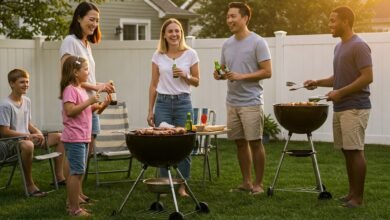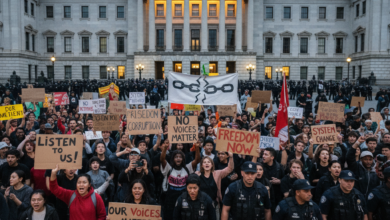The Paradox of Safety: Why Many Americans Feel Safer with a Gun?

Introduction to American Gun Culture
Gun ownership is deeply ingrained in the historical and cultural landscape of the United States. The roots of this attachment can be traced back to the Second Amendment of the Constitution, ratified in 1791, which grants citizens the right to keep and bear arms. This amendment not only reflects the founders’ intentions to safeguard against tyranny but also emphasizes the importance they placed on individual rights and personal liberties. As such, firearms have become emblematic of the American identity, representing both empowerment and responsibility.
In the early years of American founding, the nation was characterized by its frontier life. Settlers relied on firearms for survival, using them for hunting and protection against wild animals and potential threats from hostile groups. This historical reliance on guns helped establish a cultural narrative wherein owning a firearm was necessary and justifiable for personal security and self-sufficiency. As westward expansion progressed, these notions became further entrenched, leading to a romanticized view of the gun as a symbol of freedom and independence.
Throughout the 19th and 20th centuries, this cultural acceptance of firearms as integral to personal safety began to solidify. The Wild West mythos, the proliferation of gun manufacturers, and the rise of hunting and shooting sports contributed to the normalization of gun ownership in American life. Over time, guns transitioned from practical tools to symbols of personal autonomy, often touted as essential for protecting families and communities.
While gun control debates have intensified in recent years, the perception of firearms as instruments of self-defense and freedom remains deeply embedded in the American psyche. This enduring conviction can be observed in many communities across the nation, where the right to bear arms is celebrated and defended vigorously, often overshadowing discussions about the corresponding responsibilities that accompany gun ownership.
Psychological Factors Behind Gun Ownership
The relationship between firearms and the perception of safety among Americans is a complex interplay of psychological factors. A primary driver of gun ownership stems from a heightened sense of vulnerability; individuals often feel that owning a gun is a proactive measure to guard against potential threats. This feeling of vulnerability can be exacerbated by personal experiences or traumatic events, which may lead an individual to seek a sense of security that a firearm seems to provide. For instance, a past victimization could instigate a fear of crime profound enough to justify the decision to arm oneself.
Social influences play a crucial role in shaping beliefs about gun ownership and personal safety. In communities where gun ownership is common, individuals may feel social pressure to conform to these norms, viewing firearms not only as tools for protection but also as symbols of strength and independence. This can create a cycle where the act of owning a gun reinforces a perceived need for one, exacerbating fears rather than alleviating them. Moreover, familial attitudes toward firearms can significantly impact an individual’s perception of safety; those raised in gun-owning households may internalize the belief that firearms are critical for self-defense.
Media portrayals also contribute significantly to this psychological landscape. Sensationalist reporting of crime and violence can trigger feelings of fear and anxiety, prompting individuals to believe they need a firearm for protection. This fear is often disproportionate to actual crime rates, but it feeds into a mindset that prioritizes self-defense through gun ownership. Additionally, popular culture—through movies, television shows, and video games—often glorifies gun use as a solution to conflict. This portrayal can reinforce the belief that firearms are not just tools for protection but also integral to personal autonomy and empowerment.
The Perception of Crime and Safety
The perception of crime significantly influences individuals’ beliefs about their safety and security. While statistical data often reveal a downward trend in crime rates over the last few decades, public perception may not align with these figures. Many Americans report feeling more vulnerable than ever, and this feeling is often shaped by the sensationalized reporting prevalent in today’s media landscape. Media outlets frequently spotlight violent crimes, which can distort the public’s understanding of crime prevalence and severity. This result is a heightened fear of victimization, leading individuals to consider measures such as gun ownership.
Numerous studies have indicated that a significant number of individuals feel less safe even in areas that are statistically safe. Factors influencing this perception include personal experiences, community narratives, and stories shared within social networks. The psychological impact of crime sensationalism can stimulate a protective response among individuals, prompting them to carry firearms as a precautionary measure. Surveys often reveal that many gun owners cite personal security as one of the primary reasons for their ownership, reflecting a direct correlation between perceived crime risk and gun possession.
Furthermore, the debate surrounding gun ownership is often fueled by differing perspectives on safety. While advocates argue that the presence of a firearm can provide a sense of security, detractors point to the potential dangers associated with increased gun proliferation. This divergence highlights a complex relationship between perceptions of crime and individual safety measures. Ultimately, understanding how crime perceptions shape the decision to carry or own a gun is crucial in assessing the broader implications for American society and its views on personal safety and security.
Cultural and Societal Influences
The cultural narratives surrounding gun ownership in the United States have historically played a significant role in shaping the perceptions of safety among various communities. For many individuals, particularly in rural areas, guns are not merely viewed as weapons but are seen as vital tools for self-defense, hunting, and even family heritage. These sentiments have been passed down through generations, further reinforcing the belief that owning a gun contributes to an enhanced sense of security.
In numerous communities, the idea of self-reliance is a prevalent theme. Many Americans take pride in their ability to protect themselves and their families, often viewing gun ownership as an essential means of safeguarding their lives. This perspective is deeply woven into the fabric of American culture, where firearms often symbolize personal freedom and empowerment. Moreover, the portrayal of guns in media and popular culture has further cemented their status as symbols of strength, protection, and independence.
Furthermore, in certain social groups, participation in hunting is regarded not only as a recreational activity but also as a rite of passage. For these communities, guns are linked to familial traditions and values, contributing to their understanding of safety and security. In many cases, firearms are associated with bonding experiences, emphasizing their significance beyond mere functionality. The reverence for hunting culture can create a positive association with guns, further entrenching the belief that they act as instruments of safety rather than danger.
Consequently, these cultural and societal influences shape how many Americans perceive gun ownership. Among these groups, the narrative that guns enhance personal safety prevails, with cultural and familial traditions solidifying the connection between firearms and a sense of security. In this context, discussions around gun control and usage cannot be separated from the intricate tapestry of values, beliefs, and experiences that inform public attitudes toward firearms in the United States.
Political Landscape and Gun Rights Advocacy
The political landscape surrounding gun ownership in the United States is marked by a complex interplay of lobbying efforts, legislation, and public sentiment. Central to this discourse are influential organizations such as the National Rifle Association (NRA), which advocate for gun rights and seek to protect the Second Amendment. These groups often mobilize significant resources to influence policy decisions at both the federal and state levels, framing gun ownership as a fundamental personal right that contributes to individual safety. Their campaigns aim to cultivate a narrative that equates civilian gun ownership with enhanced security, thus shaping public opinion.
In recent decades, the political environment has witnessed a resurgence of debates regarding gun control, frequently igniting passionate discussions across the nation. Legislative measures aimed at regulating firearms have met with robust opposition from gun rights advocates who argue that such regulations infringe upon personal freedoms. The ongoing discourse is heightened by events such as mass shootings, which often prompt calls for stricter gun laws. However, proponents of gun rights counter that increased firearm regulation would not necessarily lead to improved safety. Instead, they argue, it may disarm law-abiding citizens while leaving them vulnerable to criminals.
This dichotomy in viewpoints highlights a critical aspect of American politics: the role of advocacy groups in influencing not just legislation but also societal attitudes toward guns. Polls frequently reveal that opinions on gun ownership and control are deeply divided along partisan lines. As such, political advocacy plays a pivotal role in reinforcing the beliefs of gun owners, who may feel that their right to bear arms serves as a safeguard against potential threats. Understanding the political dimensions of gun rights is essential to grasping the pronounced sense of security that many Americans associate with firearm ownership.
The Role of Education and Training
Education and training play a crucial role in shaping individuals’ perceptions of safety with firearms. For many gun owners, acquiring knowledge about proper firearm handling and safety protocols significantly impacts their feelings of security. Various training programs are available, ranging from basic firearm safety courses to advanced tactical training, which focus on responsible gun ownership practices and risk management.
Fundamentally, the education that accompanies firearm ownership often emphasizes the importance of understanding legislation, safe storage practices, and the responsible use of guns. Knowing the legal implications of firearm use can empower individuals, allowing them to navigate complex situations with confidence. Furthermore, training can help mitigate accidents, thereby reinforcing a sense of security among gun owners.
Moreover, structured training not only covers technical skills—like loading, unloading, and shooting accuracy—but also delves into critical thinking during high-stress scenarios. This aspect of training cultivates a mindset focused on de-escalation and awareness, further enhancing feelings of safety. When individuals feel well-prepared and knowledgeable, they are more likely to feel secure in their ability to manage firearms safely.
Community-based training initiatives also play an important role in fostering a culture of responsible gun ownership. By participating in group classes, individuals can share experiences and learn from one another, thus strengthening community ties around firearm safety. Exposure to various perspectives on gun ownership can lead to greater empathy and understanding regarding differing opinions on safety and security.
Overall, comprehensive education and training around firearms not only promote responsible gun ownership but also significantly contribute to an enhanced sense of safety for many Americans. As individuals become more educated and trained, they are better equipped to handle firearms responsibly while feeling secure in their ability to do so.
Gun Ownership and Crime Prevention: Facts and Myths
The debate surrounding gun ownership and its potential impact on crime prevention is both multifaceted and highly contentious. Advocates for gun rights often argue that owning a firearm serves as a deterrent to crime. They claim that the presence of a gun in a household can discourage criminal activity, suggesting that potential offenders may think twice if they suspect that their target may be armed. However, empirical evidence regarding this assertion is not as straightforward as this position might suggest.
Research indicates that the relationship between gun ownership and crime rates is complex. While some studies have reported instances where firearms were used successfully in self-defense, other studies highlight the risks associated with possessing a gun, such as the increased likelihood of firearm-related accidents or violence. A significant body of research suggests that households with guns are more likely to experience homicide or suicide, indicating that the potential risks may outweigh the perception of safety.
Moreover, it is crucial to dismantle certain prevalent myths surrounding gun ownership and its efficacy in reducing crime. One such myth is that higher rates of gun ownership directly correlate with lower crime rates. In fact, regions with stringent gun control laws, such as some European countries, have demonstrated lower incidences of gun violence, which might point to effective legislative measures rather than the mere presence of firearms. Conversely, areas with lax gun ownership rights often report higher crime rates, underscoring that a nuanced understanding of crime dynamics is essential.
In conclusion, while many Americans feel that gun ownership contributes to their safety and serves as a method of crime prevention, the available research suggests a more complicated narrative. Understanding the real impact of gun ownership on crime involves scrutinizing the data and separating fact from myth. The discourse must evolve to ensure informed discussions that consider the diverse realities surrounding firearms and public safety.
Alternatives to Gun Ownership for Personal Safety
In the ongoing debate surrounding personal safety in the United States, it is essential to explore non-lethal alternatives to gun ownership that can contribute to a sense of security. Individuals and communities can adopt various strategies that enhance personal safety without relying on firearms. One notable alternative is engaging in self-defense training, which empowers individuals with the skills and confidence needed to handle potentially threatening situations. Self-defense classes often encompass techniques for de-escalation, escape, and physical defense, equipping participants with a variety of responses to unsettling circumstances.
In addition to self-defense training, investing in security systems offers another layer of protection for individuals and families. Technological advancements have led to the development of affordable and user-friendly security devices, such as doorbell cameras, motion detectors, and smart locks. These systems allow homeowners to monitor their properties in real-time, receive alerts about unusual activity, and take preventive measures against potential intrusions. The presence of a well-designed security system can significantly deter criminal activity, promoting a safer environment.
Community programs also play a vital role in fostering a sense of safety among residents. Initiatives such as neighborhood watch programs and community policing efforts encourage the collaboration of citizens with law enforcement. By working together, community members can identify potential safety threats and respond proactively. Such programs not only enhance personal safety but also build trust within the community, fostering a supportive environment where individuals feel obligated to look out for one another. By considering these alternatives to gun ownership, individuals can broaden their understanding of safety and explore effective ways to protect themselves and their communities without firearms.
Conclusion: The Ongoing Debate on Safety and Gun Ownership
The discussions surrounding gun ownership and perceived safety encapsulate a complex and multifaceted issue within American society. Throughout this blog post, we have explored the various factors contributing to why many individuals feel a sense of security when possessing a firearm. These factors include cultural influences, personal experiences with crime, and a profound belief in personal responsibility for self-defense. The strong historical connection between gun ownership and American identity has further solidified the view that firearms can serve as a safeguard against perceived threats.
Moreover, research indicates that while some individuals feel empowered by having a gun, others express concerns over the implications of widespread firearm accessibility. Studies suggest that the presence of guns in homes can lead to increased instances of accidents, suicides, and unintentional shootings. This paradox creates an ongoing debate in which feelings of safety, often heightened by gun ownership, can be juxtaposed against the potential risks associated with firearms. The dilemma becomes not merely one of ownership but rather a discussion about societal values, safety measures, and public policy.
As we contemplate the relationship between gun ownership and feelings of safety, it invites individuals and communities to reflect deeply on their own views and experiences. Does owning a firearm genuinely translate into a sense of security, or does it instead represent a cultural response to fear? The complexity of this issue underscores the importance of respectful dialogue and open discussions among individuals with varying perspectives. The ongoing debate signifies that understanding the paradox of safety in relation to gun ownership is crucial in addressing the nuanced realities of American society.






















